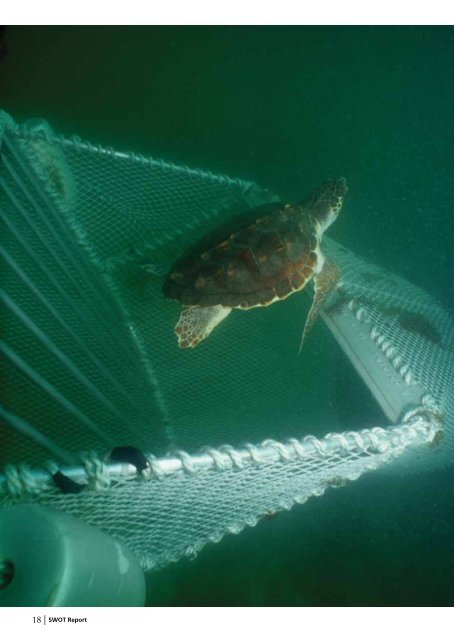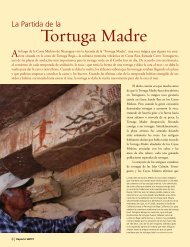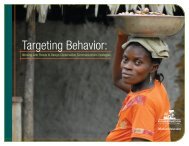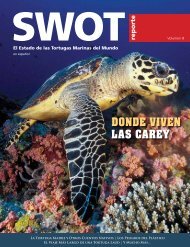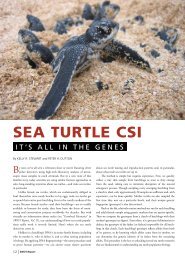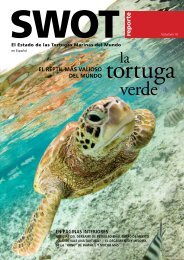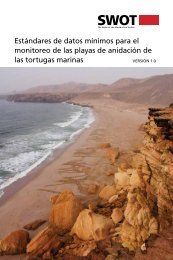18 | SWOT Report - The State of the World's Sea Turtles
18 | SWOT Report - The State of the World's Sea Turtles
18 | SWOT Report - The State of the World's Sea Turtles
You also want an ePaper? Increase the reach of your titles
YUMPU automatically turns print PDFs into web optimized ePapers that Google loves.
<strong>18</strong> | <strong>SWOT</strong> <strong>Report</strong>
Trials and<br />
Tribulations<br />
<strong>of</strong> Turtle eXcluder Devices<br />
By Nicolas J. Pilcher and CarolYN rObins<br />
Turtle excluder devices (teDs) have been shown to reduce<br />
sea turtle bycatch in trawl fisheries across <strong>the</strong> world, but<br />
<strong>the</strong>ir implementation in different fisheries has varied<br />
greatly. in <strong>the</strong> eyes <strong>of</strong> a turtle conservationist, it is hard to believe<br />
that any fisher would want to fish without a teD. Yet fishers <strong>of</strong>ten<br />
see things differently, and as with <strong>the</strong> use <strong>of</strong> any tool, <strong>the</strong> use <strong>of</strong><br />
TEDs must be mastered through experience. When teDs were<br />
originally introduced in <strong>the</strong> united states, fishing fleets battled with<br />
regulators and conservationists over teD requirements. However,<br />
today teDs are widely accepted as part <strong>of</strong> <strong>the</strong> bycatch solution and<br />
are mainstreamed into daily fishing activities throughout <strong>the</strong><br />
United states. elsewhere, teD uptake has also faced challenges.<br />
<strong>The</strong> following stories <strong>of</strong> two trawl fisheries in drastically different<br />
socioeconomic settings illustrate <strong>the</strong> challenges and successes <strong>of</strong><br />
putting teDs to work around <strong>the</strong> world.<br />
<strong>Sea</strong>TurtleStatus.org | 19
An employee <strong>of</strong> Samies Girl Fresh <strong>Sea</strong>food Market in Brisbane, Australia, displays shrimp caught using TEDs. Kristina and Harry Georges, owners <strong>of</strong> Samies Girl, proudly advertise <strong>the</strong>ir<br />
support for sea turtle conservation; not only do <strong>the</strong>y sell shrimp caught exclusively through <strong>the</strong> use <strong>of</strong> TEDs, but <strong>the</strong>y also sell insulated, reusable bags whose proceeds benefit sea turtle<br />
research and education as part <strong>of</strong> <strong>the</strong>ir Save Our <strong>Sea</strong> <strong>Turtles</strong> Foundation. © CALEN OFFIELD<br />
Australia’s Nor<strong>the</strong>rn Prawn Fishery<br />
In <strong>the</strong> early 1990s, Australia’s Commonwealth Scientific Industrial<br />
Research Organisation estimated that <strong>the</strong> country’s Nor<strong>the</strong>rn Prawn<br />
Fishery (NPF) incidentally caught 5,000–6,000 sea turtles during<br />
August to November <strong>of</strong> each year, <strong>of</strong> which 39 percent likely died.<br />
In light <strong>of</strong> <strong>the</strong>se statistics, various research organizations conducted<br />
experiments with TEDs and o<strong>the</strong>r bycatch reduction devices (BRDs).<br />
Most research projects were conducted in cooperation with <strong>the</strong> fishing<br />
industry. In 1989, <strong>the</strong> issue <strong>of</strong> sea turtle interactions with trawl operations<br />
grew more relevant with <strong>the</strong> passing <strong>of</strong> U.S. Public Law 101-162,<br />
section 609, which requires Ted-compliant certification (or equivalent<br />
bycatch reduction measures) for all countries exporting shrimp to <strong>the</strong><br />
United <strong>State</strong>s.<br />
Subsequently, scientists and gear technologists began working in<br />
cooperation with fishers and net builders to test and develop mitigation<br />
measures for turtle bycatch in <strong>the</strong> NPF. Teams <strong>of</strong> observers and gear<br />
technologists spent time on NPF vessels demonstrating how Teds work,<br />
comparing target and nontarget catches in nets with Teds versus those<br />
with regular gear, modifying Teds to suit <strong>the</strong> vessels, and assisting fishers<br />
in making Teds workable. Fisher participation in <strong>the</strong> programs was<br />
voluntary. In addition to <strong>the</strong> work done on vessels, hands-on workshops<br />
and port visits were conducted, newsletters and videos were distributed,<br />
trial Teds and Brds were loaned to fishers, and an incentive program<br />
20 | <strong>SWOT</strong> <strong>Report</strong><br />
that recognized individual contributions in <strong>the</strong> use <strong>of</strong> <strong>the</strong>se devices was<br />
created. Fishers became involved in research to address bycatch issues,<br />
and several became turtle-handling mentors, <strong>the</strong>reby assisting o<strong>the</strong>r<br />
fishers in becoming more turtle safe.<br />
Although Teds have proved to be a benefit to both sea turtles and<br />
fishers in <strong>the</strong> NPF, <strong>the</strong> adoption <strong>of</strong> Teds was initially feared by many<br />
fishers. Some were concerned about safety issues; <strong>the</strong>y imagined <strong>the</strong> large<br />
metal Teds might injure crew members. O<strong>the</strong>rs assumed that target<br />
catches would diminish, and some feared an added financial burden.<br />
Most <strong>of</strong> <strong>the</strong>se fears were put to rest as fishers modified Teds to suit <strong>the</strong>ir<br />
own fishing styles and gear. Because <strong>of</strong> <strong>the</strong> collaborative process through<br />
which Teds were introduced into <strong>the</strong> fishery, fishers and net builders<br />
had <strong>the</strong> opportunity to design and test <strong>the</strong>ir own ideas. If <strong>the</strong>ir designs<br />
were effective, <strong>the</strong>ir use was permitted. Ultimately, subsequent studies to<br />
assess catch and mortality rates <strong>of</strong> sea turtles in <strong>the</strong> NPF demonstrated<br />
that Ted use reduced sea turtle bycatch to fewer than 200 turtles per<br />
year from more than 5,000 before Teds were used. At <strong>the</strong> same time,<br />
prawn catch was down only 3 to 6 percent—a small decrease that was<br />
easily compensated for by <strong>the</strong> higher quality <strong>of</strong> <strong>the</strong> catch when using<br />
Teds, because contact with turtles in <strong>the</strong> nets was resulting in high<br />
levels <strong>of</strong> low-quality, “s<strong>of</strong>t or damaged” product.<br />
In 2000, six months after Teds became mandatory in <strong>the</strong> NPF, <strong>the</strong><br />
U.S. embargo <strong>of</strong> Australian shrimp was lifted. By <strong>the</strong>n, most <strong>of</strong> <strong>the</strong> NPF<br />
fleet had voluntarily adopted Teds, and little enforcement was necessary
to ensure compliance. Bycatch monitoring by trained fishers has now<br />
become an ongoing program, and fishers and net builders continue<br />
to design and test new types <strong>of</strong> Brds with gear technicians, scientists,<br />
and managers.<br />
Today, <strong>the</strong> NPF is considered among <strong>the</strong> most progressive shrimp<br />
trawl fisheries in <strong>the</strong> world. <strong>The</strong>re is a longstanding collaborative culture in<br />
this fishery, and over time, trust and respect have built up between fishers<br />
and scientists. <strong>The</strong> gradual and supportive approach that was adopted<br />
before Teds became mandatory was one <strong>of</strong> <strong>the</strong> keys to <strong>the</strong> effort’s success.<br />
Through this process, fishers had <strong>the</strong> opportunity to see and use <strong>the</strong> gear,<br />
collect <strong>the</strong> data needed to make decisions, and participate by designing and<br />
testing <strong>the</strong>ir own ideas. <strong>The</strong>y accepted that sea turtle bycatch existed, and<br />
<strong>the</strong>y helped solve <strong>the</strong> problem, in partnership with managers, scientists,<br />
and gear technicians. <strong>The</strong> fishing industry was not just a part <strong>of</strong> <strong>the</strong><br />
problem; it became a fundamental part <strong>of</strong> <strong>the</strong> solution.<br />
Sabah, Malaysia, Trawl Fishery<br />
In <strong>the</strong> early 1980s, <strong>the</strong> Malaysian Fisheries Department attempted<br />
to introduce TEDs in Malaysian shrimp trawl fisheries. Regrettably,<br />
<strong>the</strong> plan lacked <strong>the</strong> clarity and comprehensive education and outreach<br />
that proved successful a few years later in <strong>the</strong> NPF. <strong>The</strong> effort was<br />
confounded following <strong>the</strong> enactment <strong>of</strong> <strong>the</strong> U.S. shrimp embargo in<br />
1989, when India, Malaysia, Pakistan, and Thailand jointly and successfully<br />
contested <strong>the</strong> TED requirement as a contravention <strong>of</strong> World<br />
Trade Organization policy. A subsequent appeal by <strong>the</strong> U.S. government<br />
failed, and Malaysian fishers continued to fish without TEDs.<br />
Eventually, <strong>the</strong> U.S. certification requirement prevailed. However, <strong>the</strong><br />
Malaysian Fisheries Department’s effort to introduce TEDs had failed,<br />
and <strong>the</strong> status quo <strong>of</strong> not using TEDs remained intact.<br />
Chief among <strong>the</strong> reasons that Teds were not adopted by Malaysian<br />
trawl fishers was <strong>the</strong> general fact that creating a hole in a net, which is<br />
part <strong>of</strong> Ted installation, is contrary to much <strong>of</strong> what a fisher has learned.<br />
Indeed, Malaysian trawl fishers spend substantial amounts <strong>of</strong> time<br />
repairing holes in <strong>the</strong>ir nets. Convincing <strong>the</strong>m to actively create a 1 to 2<br />
meter (3.3 to 6.5 foot) hole in <strong>the</strong>ir nets is a difficult task, particularly<br />
when <strong>the</strong> suggestion comes from a stranger who is also not a fisher.<br />
In light <strong>of</strong> this challenge, recent efforts to re-introduce Teds in<br />
<strong>the</strong> state <strong>of</strong> Sabah, Malaysia, by a local nonpr<strong>of</strong>it organization—<strong>the</strong><br />
Marine Research Foundation (mrF)—in partnership with <strong>the</strong> Sabah<br />
Department <strong>of</strong> Fisheries have used a different strategy. Ra<strong>the</strong>r than<br />
presenting Teds principally as a way to reduce turtle bycatch, <strong>the</strong> mrF<br />
effort (begun in 2006) has emphasized Teds’ o<strong>the</strong>r abilities, such as<br />
reducing fuel costs, improving catch quality, and decreasing net repair<br />
and downtime.<br />
Drawing from lessons learned in Australia’s NPF and elsewhere, <strong>the</strong><br />
renewed Ted effort in Sabah has also focused on developing personal<br />
relationships with fishers and on creating a collaborative process for Ted<br />
trials and implementation. Biologists have been working side by side<br />
with fishers to test and adapt Teds to local boat design and fishing<br />
practices, while developing personal relationships that have been critical<br />
to <strong>the</strong> program’s success thus far. Fur<strong>the</strong>rmore, a recently organized visit<br />
Fortunately, we have observed<br />
that when TEDs are adopted,<br />
fishers who use <strong>the</strong>m<br />
rarely want to go TED-less.<br />
by Malaysian trawl fishers and fisheries <strong>of</strong>ficers to <strong>the</strong> U.S. National<br />
Marine Fisheries Service station in Pascagoula, Mississippi, has had a<br />
major positive effect on <strong>the</strong> program’s success. During <strong>the</strong>ir visit, <strong>the</strong><br />
fishers and fisheries <strong>of</strong>ficers witnessed complete (100 percent) Ted use<br />
firsthand, tested Teds under real fishing conditions, and spoke with<br />
fishers who use <strong>the</strong>m daily.<br />
Currently, <strong>the</strong> TED project in Sabah is voluntary, but efforts are<br />
under way to have TED regulations included in Malaysia’s Fisheries<br />
Act. Voluntary use <strong>of</strong> TEDs is still gradual among <strong>the</strong> broader Sabah<br />
trawl fishery, but <strong>the</strong> initial efforts by MRF, <strong>the</strong> Sabah Department <strong>of</strong><br />
Fisheries, and a small group <strong>of</strong> fishers are already having a great effect<br />
in raising awareness about TEDs and in dispelling many common fears<br />
about <strong>the</strong>ir use. <strong>The</strong> program continues to expand its work to include<br />
new fishers in new ports, with <strong>the</strong> hope that many will adopt TEDs on<br />
a voluntary basis or become better informed and prepared should TED<br />
use become mandatory.<br />
Both <strong>of</strong> <strong>the</strong> examples—Australia and Malaysia—and <strong>the</strong> pioneering<br />
efforts in U.S. fisheries suggest that <strong>the</strong> key ingredients to success in Ted<br />
implementation are voluntary fisher collaboration from <strong>the</strong> start, and a<br />
gradual approach that is based on personal relationships. Ted adoption<br />
is likely to fail without support from fishers and a wide range <strong>of</strong> stakeholders.<br />
Fortunately, we have observed that when Teds are adopted,<br />
fishers who use <strong>the</strong>m rarely want to go Ted-less. In <strong>the</strong> meantime,<br />
<strong>the</strong> lessons gleaned through <strong>the</strong> trials and tribulations <strong>of</strong> Ted implementation<br />
around <strong>the</strong> world <strong>of</strong>fer valuable advice for <strong>the</strong> road ahead. •<br />
Staff members from <strong>the</strong> Marine Research Foundation (Malaysia) work with local fishers to<br />
install TEDs in <strong>the</strong>ir trawl nets. © NICOLAS J. PILCHER<br />
PAGE <strong>18</strong>: A juvenile loggerhead escapes a trawl net through a turtle excluder device (TED)<br />
during research in Florida, U.S.A. TEDs are designed to release turtles from trawl nets<br />
through an escape hatch, while still allowing shrimp and o<strong>the</strong>r target species to enter <strong>the</strong><br />
net. © 2010 NORBERT WU / NORBERTWU.COM PAGE 19: <strong>The</strong> distinct bars <strong>of</strong> a TED are visible amid<br />
a pile <strong>of</strong> fishing nets in Queensland, Australia. © CALEN OFFIELD<br />
<strong>Sea</strong>TurtleStatus.org | 21


